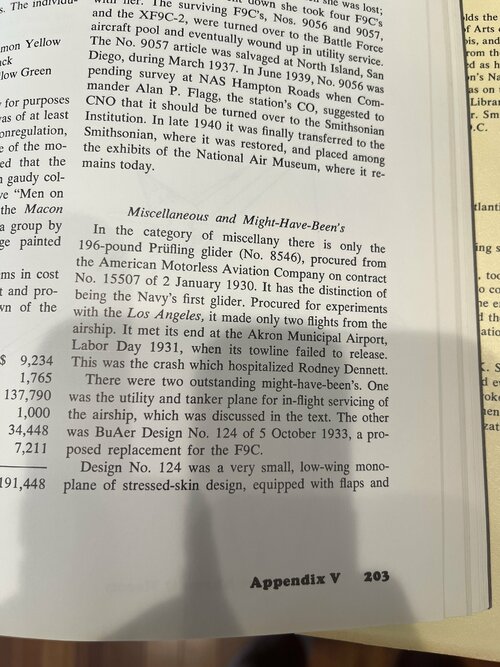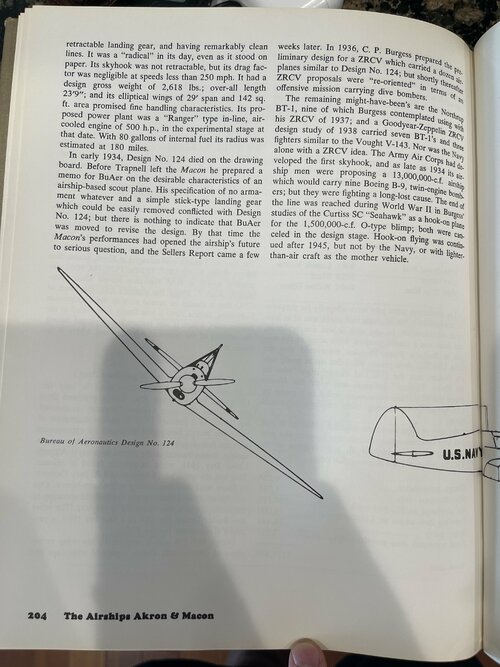For those who want to know more about the role of BuAer and the Naval Aircraft Factory in the design, procurement and production of U.S. Navy aircraft, airships and engines, esp. in the 1920s and 1930s, I recommend Dr William F. Trimble's "Wings for the Navy, a History of the Naval Aircraft Factory, 1917-1956" (USNI Press, 1990). Dr Trimble is a history faculty member at Auburn University. I might also add that the papers of aero historian Richard K. Smith (see above), including some unpublished manuscripts (among them a major study on the history of aerial refueling) have been acquired by the Auburn Univ. Library.
You are using an out of date browser. It may not display this or other websites correctly.
You should upgrade or use an alternative browser.
You should upgrade or use an alternative browser.
BuAer Design 124 Parasite Reconnaissance Aircraft?
- Thread starter cluttonfred
- Start date
Silencer1
That now I am the Ruler of the Queen's Navee!
- Joined
- 3 August 2009
- Messages
- 897
- Reaction score
- 582
Hi!
Thanks for suggestions! Actually, at the moment I'm not very interested in whole story of NAF and BuAer development, but only in the designation of their projects. These books are out of my reach....
Could you be so kind to tell, if the book about Naval Aircraft Factory contains any BuAer Design numbers, related to aircraft, produced in it?
There were small thread with such BuAer numbers http://www.secretprojects.co.uk/forum/index.php/topic,5372.0/highlight,buaer.html - with laaarge gaps in it!
Thanks in advance!
Thanks for suggestions! Actually, at the moment I'm not very interested in whole story of NAF and BuAer development, but only in the designation of their projects. These books are out of my reach....
Could you be so kind to tell, if the book about Naval Aircraft Factory contains any BuAer Design numbers, related to aircraft, produced in it?
There were small thread with such BuAer numbers http://www.secretprojects.co.uk/forum/index.php/topic,5372.0/highlight,buaer.html - with laaarge gaps in it!
Thanks in advance!
Jos Heyman
ACCESS: Top Secret
- Joined
- 15 February 2007
- Messages
- 597
- Reaction score
- 80
The book recommended provides a very good history of the Naval Aircraft Factory but does not shed any light on any obscure NAF designs or BuAer designs.
Tailspin Turtle said:He also mentions his article in Air Progress, Fall 1962, pp 20-30, "Forty Years of Skyhooks." I don't have that.
I do. It's fairly lengthy, but I can scan it. Not sure if posting the whole article here would be kosher with Management, though. Since the issue (and the magazien itself) is not exactly easily available, I'd think it'd be ok, but I don't know for sure.
- Joined
- 9 October 2009
- Messages
- 21,979
- Reaction score
- 13,640
On a related note, via HP&CA: http://www.popsci.com/diy/article/2011-04/you-built-what-retired-engineer-crafts-colossal-gliding-model-1935-airship
Once again, evidence that models and cats can be a dangerous combination!
Once again, evidence that models and cats can be a dangerous combination!
Diplomad
06/18/11 at 7:24 am I understand that the frame is actually not made of balsa. It is made from the bones of the cat that ruined the original model.
The Stannum Crusader
ACCESS: Restricted
- Joined
- 14 October 2022
- Messages
- 35
- Reaction score
- 43
I disagree that the layout is too modern, the HE112 was designed in 1933 as well and has a similar layout.Hi!
With an Admiral, old sea wolf, as a chief designer
The aircraft layout, in my humble opinion, is too advanced for 1933.
Moreover, in the US Navy, most of the period's aircraft were biplanes.
The monoplane could reach more maximum speed, although its low-speed characteristics (which has been required for flying carrier operations) were not as low as for conventional biplane.
In any case, the speed of airship is factor, influencing the characteistic of parasite aircraft.
- Joined
- 22 January 2006
- Messages
- 4,216
- Reaction score
- 2,018
AgreeI disagree that the layout is too modern, the HE112 was designed in 1933 as well and has a similar layout.
First generation of monoplane fighters was designed from late 20's to early 30's. Biplane fighters still remained in large numbers almost to the end of the decade.
Boeing P-26 First flight 1932
Polikarpov I-16 First flight 1933
Curtiss P-36 (P-26 replacement)/Hawker Hurricane/Messerschmitt Bf109 First Flight 1935. Introduced in service from 1936
The Stannum Crusader
ACCESS: Restricted
- Joined
- 14 October 2022
- Messages
- 35
- Reaction score
- 43
And I guess the BuAer 124 is sort of a more modern design, I’d imagine around 1936, but the HE112 has a very similar form factor, so even though it is ahead in form than these early short stubby monoplanes it isn’t out of the realm of possibilityAgree
First generation of monoplane fighters was designed from late 20's to early 30's. Biplane fighters still remained in large numbers almost to the end of the decade.
Boeing P-26 First flight 1932
Polikarpov I-16 First flight 1933
Curtiss P-36 (P-26 replacement)/Hawker Hurricane/Messerschmitt Bf109 First Flight 1935. Introduced in service from 1936
The Stannum Crusader
ACCESS: Restricted
- Joined
- 14 October 2022
- Messages
- 35
- Reaction score
- 43
The big question though is whether or not anyone has found any actual documents on the subject yet, or if we are still just going off of like one or two sources. Surely there would be more than just a picture or two?
The Stannum Crusader
ACCESS: Restricted
- Joined
- 14 October 2022
- Messages
- 35
- Reaction score
- 43
The Stannum Crusader
ACCESS: Restricted
- Joined
- 14 October 2022
- Messages
- 35
- Reaction score
- 43
Some time within a few years I’ll go check National Archives Record Group 72, I assume 72.4.6 which is the Records of the Airframe Design Division and the Design Elements Division would have some more on the plane.
Similar threads
-
U.S.Navy-BuAer Specification SD 112.14 (1938)
- Started by lark
- Replies: 9
-
-
US Navy Preliminary Airplane Design Branch (BuAer) Designs
- Started by RyanC
- Replies: 2
-
-
Martin 313 Submaster (XP7M-1): Open Ocean ASW Seaplane
- Started by Stargazer
- Replies: 13


